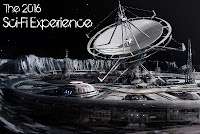Starplex by Robert J. Sawyer
Published: Ace Books/Analog, 1996
Awards Nominated: Hugo and Nebula Awards
The Book:
“In the future, the discovery of artificial wormholes has put the sentient Earth races (humans and dolphins) in contact with their counterparts from two other worlds, the argumentative Waldahudins and polite, long-lived Ibs. For diplomacy and managing future first contact situations, the vessel Starplex was designed, with an environment that allows all four races to live and work together.
Keith Lansing is the current director of Starplex, and his watch is filled with wonders, disasters and personal struggles. He will lead his crew through scientific mysteries, encounters with new species, and even violent conflict, all while struggling to master his own midlife crisis.” ~Allie
 This is another one I listened to on audiobook, and it's my next installment for Stainless Steel Droppings' Sci-Fi Experience. Instead of listening on commute, my husband and I both listened to this one together during long car trips. As our first jointly-listening-audiobook, I think this one was quite a success. This is my third Sawyer novel, after Hominids and The Terminal Experiment. Sawyer stated in the introduction that this novel was his ‘swan song’ for far future science fiction, as he planned to shift his focus to near-future stories. This one makes me think I should check out some more of his earlier work, because his far future stories are pretty fun!
This is another one I listened to on audiobook, and it's my next installment for Stainless Steel Droppings' Sci-Fi Experience. Instead of listening on commute, my husband and I both listened to this one together during long car trips. As our first jointly-listening-audiobook, I think this one was quite a success. This is my third Sawyer novel, after Hominids and The Terminal Experiment. Sawyer stated in the introduction that this novel was his ‘swan song’ for far future science fiction, as he planned to shift his focus to near-future stories. This one makes me think I should check out some more of his earlier work, because his far future stories are pretty fun!
My Thoughts:
My strongest impression of Starplex is that this was a very busy book. There are so many ideas, mysteries and subplots packed in that I was skeptical it would come to a coherent end. Sawyer mentioned in the introduction that he wanted to address many of the cosmological questions of our time, and it was a fun surprise to see what fictional answers were provided. Some of the topics included were dark matter, the expansion of the universe, and the formation of spiral galaxies. While there was never a dull moment, it sometimes felt like the story was jumping from subplot to subplot, without a strong enough central thread to hold everything together. The most central, continuous story would be Keith’s midlife crisis and his relationship with his wife, Rissa, and I felt like this came to a nice resolution by the end of the story.
Keith and Rissa were interesting characters, but the rest of the crew also brought the story to life. All four sentient races were represented aboard Starplex, and I really liked how their physiology and culture shaped their personalities. On the level of stereotype, each alien race was translated into a particular accent— Brooklyn for the argumentative Waldahudin and a prim British accent for the polite Ibs. The dolphins played a smaller role, but also had a distinct view of life. The wide variety in character perspective really enriched the setting and the interactions between characters.
Speaking of the setting, I really enjoyed this universe. I liked that Starplex was not built on a military model, and I loved the emphasis on science and diplomacy. I liked all the detail that went into the imagining of a starship that could support each species in separately in comfort, and adequately together. The crew faced some entertaining scientific puzzles and problems, and it was fun to watch them reason their way through. In addition, there was some space-based combat that occurs later in the book, for those who like a bit more action. Even this conflict involved entertaining considerations of physics, especially since the diplomatic Starplex does not have anything designed to be a weapon. Altogether, it was a very fun book, set in a lively universe that I can still hope he will revisit one day!
My Rating: 4/5
Starplex is my favorite Sawyer novel to date. His far-future universe was a very interesting place, and I liked the different perspective his various sentient alien species brought to the story. There is a big focus on cosmology and physics in the story, which provides fictional answers for a number of open questions. I really loved how the story revolved around scientists solving problems and mysteries, and how physics considerations came into play in ship maneuvers and the small amount of combat. It seemed like there were almost too many different subplots folded into this compact novel, but I was satisfied by how all of the important points were resolved in the end. Starplex was a very entertaining book!

Thanks for sharing this information. To know more click on stainless steel j profile
ReplyDelete